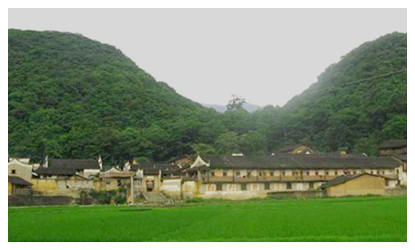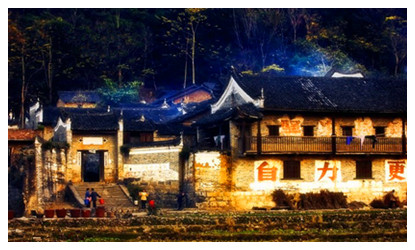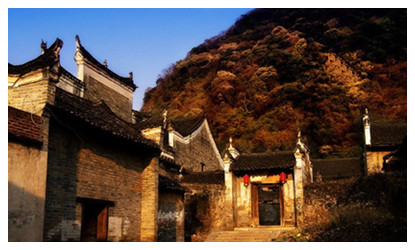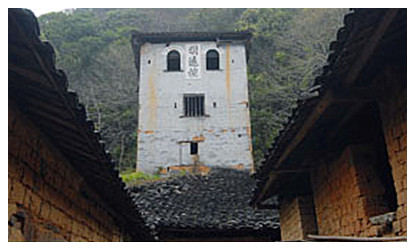
Baojing Ancient Village
 Baojing Village, a famous ancient village, is located in Daxu Town,Jianghua Yao Minority Autonomous County, Yongzhou City, Hunan Province, and it borders with Hezhou City of Guangxi Zhuang Autonomous Region. Situated in the mountain basin in the east of Mengzhu Mountain at the cross of Hunan and Guangxi, ,it is 38 km away from the southwest of the county town.
Baojing Village, a famous ancient village, is located in Daxu Town,Jianghua Yao Minority Autonomous County, Yongzhou City, Hunan Province, and it borders with Hezhou City of Guangxi Zhuang Autonomous Region. Situated in the mountain basin in the east of Mengzhu Mountain at the cross of Hunan and Guangxi, ,it is 38 km away from the southwest of the county town.
Legend & History
About 360 years ago, a man named He Yingqi, drove a flock of ducks along a river called "Great River" , to Baojing. When feeling good feng-shui (geomantic omen) there, he stopped traveling further and got married there.
 According to the record on the Family Tree of He Clan, Baojing Ancient Village was established during the reign of Emperor Shunzhi in the Qing Dynasty (1644-1661). Containing 108 rooms in all, it has a history of more than 360 years.
According to the record on the Family Tree of He Clan, Baojing Ancient Village was established during the reign of Emperor Shunzhi in the Qing Dynasty (1644-1661). Containing 108 rooms in all, it has a history of more than 360 years.
It took the efforts of 6 generations to develop the He Clan from a common family which made his living on raising ducks to a shining light (all the military or civil officials had to dismount when passing by the village on the horses).
During the prime time of Baojing Village, there were four masts in front of Bazilou (8-
 According to the record on the Family Tree of He Clan, Baojing Ancient Village was established during the reign of Emperor Shunzhi in the Qing Dynasty (1644-1661). Containing 108 rooms in all, it has a history of more than 360 years.
According to the record on the Family Tree of He Clan, Baojing Ancient Village was established during the reign of Emperor Shunzhi in the Qing Dynasty (1644-1661). Containing 108 rooms in all, it has a history of more than 360 years.It took the efforts of 6 generations to develop the He Clan from a common family which made his living on raising ducks to a shining light (all the military or civil officials had to dismount when passing by the village on the horses).
During the prime time of Baojing Village, there were four masts in front of Bazilou (8-

Character Tower) on the very edge of the village. Next to the masts erected a stele called "ma-dao-zhi (stopping the horse here)", with such words as "military and civil officials demount here" inscribed on it.
In more than 300 years, Baojing Ancient Village gradually developed itself into a well-known garden-like complex of buildings. Facing west and with a total area of 80-odd mu (0.5336 hectares), the whole complex is composed of five parts from north to south, Weizidi, Daxin house, Laotang house, Xiaxin house and Xin house.
What to see?
Mingyuan Tower, situated at the north edge of the village, was used for defense and observation. The embrasure set on the wall of the tower is wide inside and narrow outside.
and observation. The embrasure set on the wall of the tower is wide inside and narrow outside.
Zouma Wooden House
In more than 300 years, Baojing Ancient Village gradually developed itself into a well-known garden-like complex of buildings. Facing west and with a total area of 80-odd mu (0.5336 hectares), the whole complex is composed of five parts from north to south, Weizidi, Daxin house, Laotang house, Xiaxin house and Xin house.
What to see?
Mingyuan Tower, situated at the north edge of the village, was used for defense
 and observation. The embrasure set on the wall of the tower is wide inside and narrow outside.
and observation. The embrasure set on the wall of the tower is wide inside and narrow outside.Zouma Wooden House
At the south edge of the village is a place called Zouma wooden house. The lower floor was used as a stable and the upper one a living quarter for long-term laborers.Mendang (a nickname of the pair of woods above a door frame) on the door of Xin House was engraved based on Bagua (Eight-diagram) Pattern. The right one is Qian (Heaven) Pattern and the left Kun (Earth) Pattern.The main room was once functioned as the meeting room of the whole clan, later as the dining hall of people's commune.
The manpower and resources utilized to build such a colossal ancient complex was huge. The splendor of the He Clan in Baojing Village was reflected in the following facts. It took nine years for the completion of Xin House, and 3 and a half years was spent by 40-plus artisans on grinding stones for construction materials. Some stones were as long as 5 meters and as heavy as about a ton; some steles were 2 square meters in size. And all of the laneways and open ground were paved by blue stone slab.
As all of the 108 rooms of the whole village connect to one another, no matter in sunny or rainy days, the villagers won't be influenced with the weather. The air here is quite fresh and climate comfortable. The enclosed courtyard, with blue stone paved ground, looks very tidy and magnificent. The woodcarving doors and windows, and colored mural paintings can be seen everywhere, vividly demonstrating the typical layout of the South China architecture.
The manpower and resources utilized to build such a colossal ancient complex was huge. The splendor of the He Clan in Baojing Village was reflected in the following facts. It took nine years for the completion of Xin House, and 3 and a half years was spent by 40-plus artisans on grinding stones for construction materials. Some stones were as long as 5 meters and as heavy as about a ton; some steles were 2 square meters in size. And all of the laneways and open ground were paved by blue stone slab.
As all of the 108 rooms of the whole village connect to one another, no matter in sunny or rainy days, the villagers won't be influenced with the weather. The air here is quite fresh and climate comfortable. The enclosed courtyard, with blue stone paved ground, looks very tidy and magnificent. The woodcarving doors and windows, and colored mural paintings can be seen everywhere, vividly demonstrating the typical layout of the South China architecture.






 Ask Questions ?
Ask Questions ?